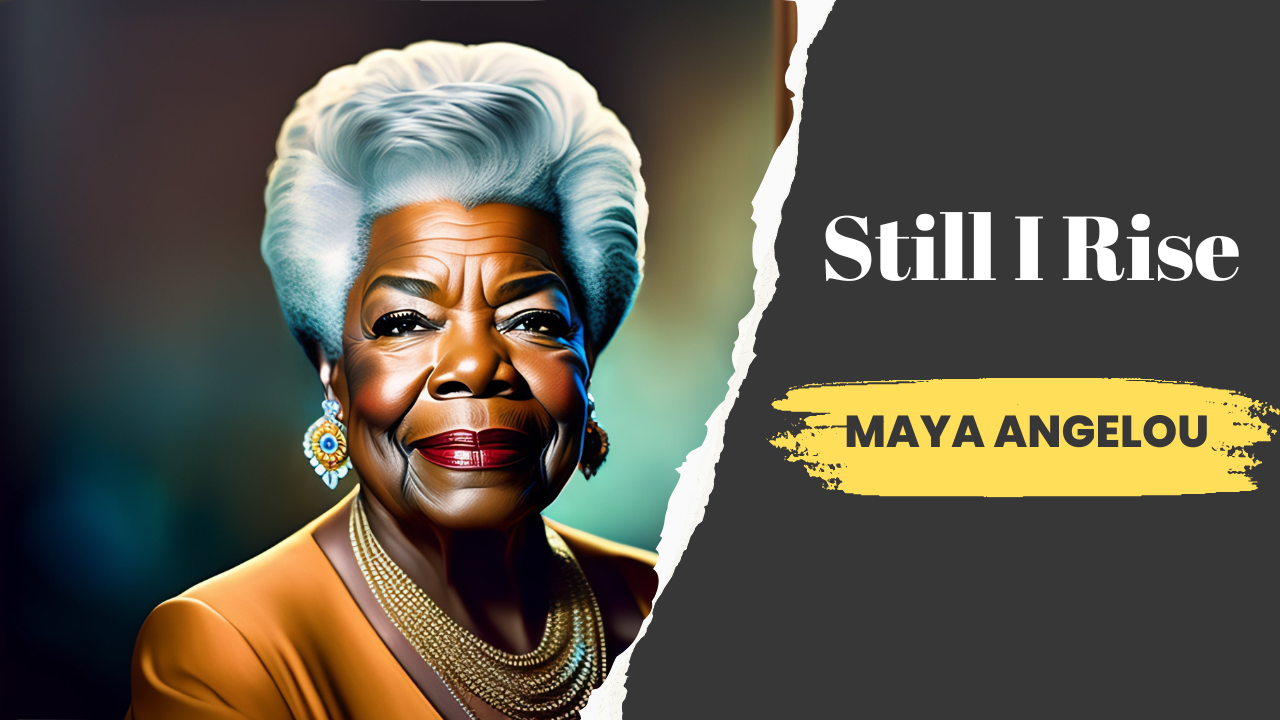Still I Rise by Maya Angelou
Summary and Analysis
The poem “Still I Rise” by Maya Angelou is a potent piece of writing that examines themes of resiliency, determination, and strength in the face of oppression and adversity. The poem was written by Angelou. The poem is frequently interpreted as a feminist statement, celebrating the strength and beauty of women, in particular women of colour. Within the scope of this critical analysis, we will investigate not only the historical and cultural context of the poem, but also its imagery, metaphor, and repetition throughout.
Still I Rise
You may write me down in history
With your bitter, twisted lies,
You may trod me in the very dirt
But still, like dust, I’ll rise.
Does my sassiness upset you?
Why are you beset with gloom?
’Cause I walk like I’ve got oil wells
Pumping in my living room.
Just like moons and like suns,
With the certainty of tides,
Just like hopes springing high,
Still I’ll rise.
Did you want to see me broken?
Bowed head and lowered eyes?
Shoulders falling down like teardrops,
Weakened by my soulful cries?
Does my haughtiness offend you?
Don’t you take it awful hard
’Cause I laugh like I’ve got gold mines
Diggin’ in my own backyard.
You may shoot me with your words,
You may cut me with your eyes,
You may kill me with your hatefulness,
But still, like air, I’ll rise.
Does my sexiness upset you?
Does it come as a surprise
That I dance like I’ve got diamonds
At the meeting of my thighs?
Out of the huts of history’s shame
I rise
Up from a past that’s rooted in pain
I rise
I’m a black ocean, leaping and wide,
Welling and swelling I bear in the tide.
Leaving behind nights of terror and fear
I rise
Into a daybreak that’s wondrously clear
I rise
Bringing the gifts that my ancestors gave,
I am the dream and the hope of the slave.
I rise
I rise
I rise.
Maya Angelou

The poem is structured with seven stanzas, each of which has a rhyme scheme that is consistent throughout the poem and a refrain that repeats either “I rise” or “I’ll rise.” The purpose of this repetition is to emphasise the main theme of the poem, which is the power of overcoming adversity. The speaker of the poem begins by addressing her oppressors and the various ways in which they attempt to keep her down. She acknowledges their efforts but assures them that she will continue to rise regardless of what they do. This first stanza of the poem establishes the speaker’s resolve and resilience in the face of adversity, which is a theme that continues throughout the rest of the poem.
This theme is carried over into the second stanza, where the speaker discusses the long history of oppression and violence that she and her ancestors have been subjected to. She describes the anguish and distress that has been inflicted upon them, but she reiterates that they will prevail despite it all. This stanza emphasises the significance of cultural memory as well as the resiliency of communities in the face of oppression that stems from systemic factors.
In the third stanza, the speaker envisions a world in which she and her people are no longer subjected to oppression. She does this by turning her attention to the future. She discusses the possibility of freedom and equality, and she reiterates that she will rise above her current situation. In spite of the seemingly insurmountable obstacles, this stanza is intended to instil hope and fortitude in its readers.

The speaker does some self-reflection on her own abilities and discusses both her strengths and weaknesses in the fourth and final stanza of the poem. She admits that there are times when she may feel broken, but she assures herself as well as her readers that she will always be able to rise again. This stanza emphasises the significance of practising self-care and loving oneself even in the face of challenging circumstances.
The speaker makes a proclamation about her power and strength in the fifth stanza of the poem, which is perhaps the most triumphant of all the stanzas. She reminds her oppressors that they will never be able to bring her down by talking about her bravery and determination, and she says that she will never back down. This stanza encourages readers, particularly women and people of colour, to claim their own power and strength in the face of oppression. This is one of the stanza’s primary purposes.
In the sixth line of the poem, the speaker discusses the concept of beauty as well as the pressure that women, particularly women of colour, feel to conform to certain standards of beauty. She insists that she is stunning in her own unique way, and that nobody or nothing can ever change that about her. This stanza seeks to challenge the expectations of society while simultaneously celebrating the beauty and power that diversity possesses.

In the seventh and final stanza of the poem, the speaker reiterates that she will prevail over adversity. She tells those who oppress her that they can try all they want, but they will never be successful in bringing her down. She concludes the poem with an uplifting and inspiring message about overcoming adversity. This stanza is meant to encourage readers that they should never give up in the face of adversity, but rather that they should always rise above it.
The speaker’s strength and resolve come across clearly in the poem thanks to the evocative imagery and metaphors that are used. For instance, the refrain of “I rise” is a powerful metaphor for resilience and the ability to triumph over adversity because it is repeated over and over again. The poem also makes use of imagery associated with water, specifically the “tides,” “ocean,” and “waves” in order to communicate the concepts of movement and transformation. The use of this imagery serves as a means to emphasise how important it is to maintain a resilient and adaptable mindset in the face of systemic oppression.
In terms of the cultural and historical context, “Still I Rise” was written in 1978, during a period of significant social and political upheaval in the United States. This coincided with the civil rights movement in the United States. Although the Civil Rights Movement had just recently come to a close, the struggle for racial equality and justice was far from over. During this time period, women were fighting for equal rights and representation, which led to the rise of the feminist movement, which gained momentum during this time period. It is possible to interpret Maya Angelou’s poem as a reflection of her own experiences as a black woman living in the United States. Angelou was a prominent figure in both of these movements.

The poem can also be read as a response to the negative stereotypes and representations of black women that were prevalent in mainstream media and culture at the time. One way to do this is to read the poem as a response to the poem itself. Angelou subverts these notions and celebrates the power, beauty, and resiliency of black women in her work. The poem is a powerful declaration of pride and self-love, and it serves as a reminder to readers that they are worthy of respect and dignity, regardless of what society may say about them.
Overall, “Still I Rise” is a moving and thought-provoking poem that honours the resiliency, strength, and beauty of women, particularly women of colour. The poem was written by Adrienne Rich. The poem expresses a message of hope and determination in the face of adversity through the use of evocative imagery, metaphor, and repetition throughout its lines. The historical and cultural setting of the poem lends it an additional layer of meaning, as it can be interpreted as a reaction to the institutionalised oppression and negative stereotypes that black women were forced to contend with in the late 1970s. The poem, which is a testament to the power of resiliency and self-love, is still applicable, inspiring, and a source of motivation in modern times.

